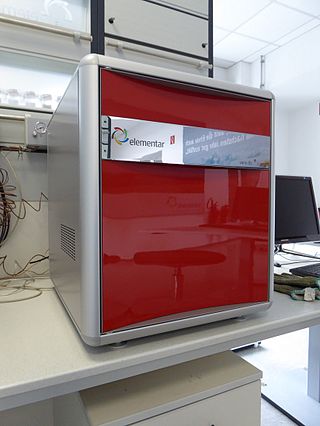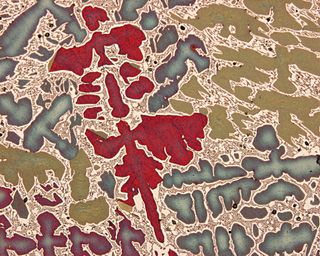
Analytical chemistry studies and uses instruments and methods to separate, identify, and quantify matter. In practice, separation, identification or quantification may constitute the entire analysis or be combined with another method. Separation isolates analytes. Qualitative analysis identifies analytes, while quantitative analysis determines the numerical amount or concentration.

Spectroscopy is the field of study that measures and interprets electromagnetic spectra. In narrower contexts, spectroscopy is the precise study of color as generalized from visible light to all bands of the electromagnetic spectrum.
Spectrometry may refer to:

An ion source is a device that creates atomic and molecular ions. Ion sources are used to form ions for mass spectrometers, optical emission spectrometers, particle accelerators, ion implanters and ion engines.
Gold fingerprinting is a method used to identify and authenticate gold items by analyzing the unique composition of impurities or trace elements within the metal. While gold itself is an inert and relatively uniform element, gold found in natural or processed items often contains small amounts of other elements, such as silver or lead. These trace elements, which vary depending on the source and refining process, serve as a "fingerprint" for the gold. By comparing the elemental composition of a gold sample to databases of known sources, experts can determine where the gold was likely mined or processed. This technique is applied in fields such as archaeology, geology, and forensic science, as it provides insights into the provenance of historical artifacts, mined gold, or stolen items.
Wavelength-dispersive X-ray spectroscopy is a non-destructive analysis technique used to obtain elemental information about a range of materials by measuring characteristic x-rays within a small wavelength range. The technique generates a spectrum in which the peaks correspond to specific x-ray lines and elements can be easily identified. WDS is primarily used in chemical analysis, wavelength dispersive X-ray fluorescence (WDXRF) spectrometry, electron microprobes, scanning electron microscopes, and high precision experiments for testing atomic and plasma physics.
A microprobe is an instrument that applies a stable and well-focused beam of charged particles to a sample.

Elemental analysis is a process where a sample of some material is analyzed for its elemental and sometimes isotopic composition. Elemental analysis can be qualitative, and it can be quantitative. Elemental analysis falls within the ambit of analytical chemistry, the instruments involved in deciphering the chemical nature of our world.
Ion beam analysis (IBA) is an important family of modern analytical techniques involving the use of MeV ion beams to probe the composition and obtain elemental depth profiles in the near-surface layer of solids. IBA is not restricted to MeV energy ranges. It can be operated at low energy (<Kev) using techniques such as FIB, and Secondary ion mass spectroscopy, as well as at higher energies (>GeV) using instruments like the LHC. All IBA methods are highly sensitive and allow the detection of elements in the sub-monolayer range. The depth resolution is typically in the range of a few nanometers to a few ten nanometers. Atomic depth resolution can be achieved, but requires special equipment. The analyzed depth ranges from a few ten nanometers to a few ten micrometers. IBA methods are always quantitative with an accuracy of a few percent. Channeling allows to determine the depth profile of damage in single crystals.

Characterization, when used in materials science, refers to the broad and general process by which a material's structure and properties are probed and measured. It is a fundamental process in the field of materials science, without which no scientific understanding of engineering materials could be ascertained. The scope of the term often differs; some definitions limit the term's use to techniques which study the microscopic structure and properties of materials, while others use the term to refer to any materials analysis process including macroscopic techniques such as mechanical testing, thermal analysis and density calculation. The scale of the structures observed in materials characterization ranges from angstroms, such as in the imaging of individual atoms and chemical bonds, up to centimeters, such as in the imaging of coarse grain structures in metals.

Institute of Physics, Bhubaneswar is an autonomous research institution of the Department of Atomic Energy (DAE), Government of India. The institute was founded by Professor Bidhu Bhusan Das, who was Director of Public Instruction, Odisha, at that time. Das set up the institute in 1972, supported by the Government of Odisha under the patronage of Odisha's education minister Banamali Patnaik, and chose Dr. Trilochan Pradhan as its first director, when the Institute started theoretical research programs in the various branches of physics. Other notable physicists in the institute's early days included Prof. T. P. Das, of SUNY, Albany, New York, USA and Prof. Jagdish Mohanty of IIT Kanpur and Australian National University, Canberra. In 1981, the Institute moved to its present campus near Chandrasekharpur, Bhubaneswar. It was taken over by the Department of Atomic Energy, India on 25 March 1985 and started functioning as an autonomous body.
Gas cluster ion beams (GCIB) is a technology for nano-scale modification of surfaces. It can smooth a wide variety of surface material types to within an angstrom of roughness without subsurface damage. It is also used to chemically alter surfaces through infusion or deposition.

Instrumental analysis is a field of analytical chemistry that investigates analytes using scientific instruments.
The following outline is provided as an overview of and topical guide to biophysics:
Nuclear forensics is the investigation of nuclear materials to find evidence for the source, the trafficking, and the enrichment of the material. The material can be recovered from various sources including dust from the vicinity of a nuclear facility, or from the radioactive debris following a nuclear explosion.

Resonance ionization is a process in optical physics used to excite a specific atom beyond its ionization potential to form an ion using a beam of photons irradiated from a pulsed laser light. In resonance ionization, the absorption or emission properties of the emitted photons are not considered, rather only the resulting excited ions are mass-selected, detected and measured. Depending on the laser light source used, one electron can be removed from each atom so that resonance ionization produces an efficient selectivity in two ways: elemental selectivity in ionization and isotopic selectivity in measurement.








